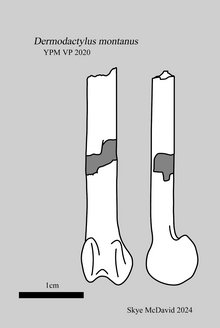Dermodactylus
| Dermodactylus Temporal range:
| |
|---|---|

| |
metacarpal
| |
| Scientific classification | |
| Domain: | Eukaryota |
| Kingdom: | Animalia |
| Phylum: | Chordata |
| Order: | †Pterosauria |
| Suborder: | †Pterodactyloidea |
| Family: | †Incertae sedis |
| Genus: | †Dermodactylus Marsh, 1881 |
| Species: | †D. montanus
|
| Binomial name | |
| †Dermodactylus montanus (Marsh, 1878)
| |
| Synonyms | |
| |
Dermodactylus (meaning "skin finger", from Greek derma and daktylos, in reference to
a single partial bone, from the hand.History and classification
Dermodactylus is based on a single
Its place within the Pterosauria is uncertain, beyond the Pterodactyloidea.[6] The material it is based on is too meager for further classification (although Carpenter et al.. [2003] note that the shape of the bone's articular end means that it did not belong to an ornithocheirid, a type of short-tailed pterosaur that often had a head crest and/or large teeth),[7] or for adding additional remains to the genus with any certainty, and so it is now regarded as a dubious pterodactyloid.[7][8][9][10] It was not even mentioned in the most recent major popular work on pterosaurs.[11]
Paleobiology
Marsh suggested it had a wingspan of 1.5-1.8 meters (5–6 feet),[4] but this is including the material excluded by Peter Wellnhofer, who estimates the wingspan of the only known individual at 1 meter (3.28 feet).[2] John Foster estimates its weight at 3.3 kilograms (7.3 pounds). It would probably have been a small aerial carnivore.[12]
See also
References
- ^ YPM=Yale University Peabody Museum of Natural History, New Haven, Connecticut.
- ^ ISBN 978-0-7607-0154-6.
- .
- ^ .
- ISBN 978-3-437-30269-5.
- ISBN 978-0-7607-0154-6.
- ^ ISBN 978-1-86239-143-7.
- ^ Harris, Jerald D.; Carpenter, Kenneth (1996). "A large pterodactyloid from the Morrison Formation (Late Jurassic) of Garden Park, Colorado". Neues Jahrbuch für Geologie und Paläontologie - Monatshefte. 8: 473–484.
- ISBN 978-0-7864-2295-1.
- ^ King, Lorin R.; Foster, John R.; Scheetz, Rodney D. (2006). "New pterosaur specimens from the Morrison Formation and a summary of the Late Jurassic pterosaur record of the Rocky Mountain region". In Foster, John R.; Lucas, Spencer G. (eds.). Paleontology and Geology of the Upper Jurassic Morrison Formation. New Mexico Museum of Natural History and Science Bulletin. Vol. 36. Albuquerque, New Mexico: New Mexico Museum of Natural History and Science. pp. 149–161.
- ISBN 978-0-13-146308-0.
- ^ Foster, John R. (2003). Paleoecological Analysis of the Vertebrate Fauna of the Morrison Formation (Upper Jurassic), Rocky Mountain Region, U.S.A. New Mexico Museum of Natural History and Science Bulletin, 23. Albuquerque, New Mexico: New Mexico Museum of Natural History and Science. p. 37.
Further reading
- James A. Jensen; John H. Ostrom (July 1977). "A Second Jurassic Pterosaur from North America". Journal of Paleontology. 51 (4): 867–870.
